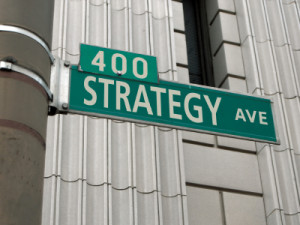by gabriel_sales | Aug 20, 2013
 In today’s technology-driven world, your B2B marketing plan is mainly going to consist of digital content marketing and web content management. In this blog, we give a very basic overview for how to build a B2B marketing plan to improve lead generation and drive revenue.
In today’s technology-driven world, your B2B marketing plan is mainly going to consist of digital content marketing and web content management. In this blog, we give a very basic overview for how to build a B2B marketing plan to improve lead generation and drive revenue.
The first part of your marketing plan is about research and development. You need to determine what market you are going after and create an idea customer profile. An idea customer profile contains information about the ideal demographics for your target customer; this can include things like region, title, industry, department, etc. Once you know who you are selling to, it is much easier to create marketing content for them.
The next part of your B2B marketing plan is actual content development itself. Using the information you know about your ideal customer profile, consider what information would be relevant or valuable to your target customer. You also need to create content that is designed specifically for each stage of the buying cycle. For example, early stage prospects need to be educated; late-stage buyers need to be convinced. By having different pieces of marketing content for each stage of the buying cycle, your prospects will feel like you understand their needs and begin to trust you.
The final stage of your B2B marketing plan is execution and refinement. With your content created, you can then push your messaging over blogs, your website and social media. With later-stage content, it is a good idea to keep it “gated” and require prospects to fill out a form with their contact information to get access. This way, you will know who your prospects are as they are nearing the close (with a marketing automation platform, you can track prospects from their first interaction on your website). Once your content is out there, you can use a variety of analytics to help you understand where have been successful and where you need improvement. You then make small adjustments over time by refining your messages or trying out different social networking or video hosting platforms.
If you would like more detailed content on B2B marketing plans, click here. If you have any questions, please feel free to contact us.
by gabriel_sales | Aug 16, 2013
 This blog is a short overview of the advantages your company can gain when outsourcing B2B sales.
This blog is a short overview of the advantages your company can gain when outsourcing B2B sales.
For many B2B companies, selling is not as straightforward as it used to be. These companies are realizing that their sales and marketing tactics from ten years ago (telemarketing, tradeshows, etc.) are no longer as effective as they used to be.
In light of recent technological innovation and cultural evolution that has changed the buying and selling game for everyone, many B2B companies are turning to experts to help them transition into the digital marketing era. A sales and marketing outsourcing company can help you develop a clear sales process, execute marketing campaigns efficiently, and give you the metrics you need constantly refine your strategy.
Here are three advantages for outsourcing B2B sales:
- History of Experience
While your B2B company has expertise in the products or services you offer, a B2B sales outsourcing company has expertise in selling things. The world of selling is the water they’re swimming in, so they have been keeping track of all the new sales tactics and strategies that you’ve been ignoring while building your business. By hiring an outsourcing company for B2B sales, you get access to this experience and expertise.
- Marketing Automation Expertise
A new survey from MarketingProfs showed that 62% of marketers are now leveraging a marketing automation platform as a part of their sales strategy. For non-experts, marketing automation implementation is not an easy task, and it can be difficult to know if you are getting the most out of your investment. By outsourcing B2B sales, you get access to a sales outsourcing team that has gone through dozens of marketing automation implementations and knows the software in and out.
3. Measurable Results
One of the great things coming out of the recent technological innovations in marketing is the ability to measure results. Using a marketing automation platform and sales technologies (cold calling software programs, customer relationship management software, etc.), you can start to attach numbers and percentages to all of your B2B sales and marketing tactics—eventually giving you the ability to forecast your sales cycle with greater accuracy.
Overall, outsourcing B2B sales can add enormous value to your business with relatively little risk. Leveraging a B2B outsourcing sales company will give you the ability to act as an expert in the digital content marketing landscape and help drive revenue in ways you may not have even heard of yet.
We Can Help
Gabriel Sales was created and founded by Glen Springer in 2001 to accelerate sales and market growth for new products and services, and fill strategic gaps in companies’ sales and marketing operations. Gabriel Sales has continued evolve best practices with a focus on sales and marketing alignment. We integrate digital content and social media into every reps sales process to increase accountability and metric driven results.
Our team has a diverse experience and deep domain expertise selling software, hardware, professional services, analytics and media. Our core focus is taking products and sales efforts through multiple stages of maturity in their path from $0-$20M in annual revenue. We continue to be selective in our partnerships, ensuring that each client gets a dynamic, measurable plan to meet sales and growth projections.
If you would like more information on how selling and buying have changed and what you need to do to adapt, you can download our new white paper called, “New Rules for B2B Sales & Marketing in 2013”. If you have any questions, please feel free to check out our services page or contact us.
by gabriel_sales | Aug 15, 2013
 Building landing pages that convert is both a science and an art. You need to present information in a logical way with a visually inviting format—without selling too hard. Note easy, but not impossible either.
Building landing pages that convert is both a science and an art. You need to present information in a logical way with a visually inviting format—without selling too hard. Note easy, but not impossible either.
Here are 5 Tips for Landing Page Conversion Success:
- Get rid of the “Submit” button.
I know that the word “submit” is a clear denotation for what is happening when someone fills out a form on a landing page but tell me, what’s exciting about “submitting” anything? Ever? Nothing. So, don’t put it on your landing page forms.
Make your form button a place where you restate the value of what your prospects are getting when they fill out your form, i.e. “Get My White Paper Now” or “Send Me More Information”. Like Amazon’s “Buy with 1-Click” button, reminding people of what they are getting out of the transaction makes them much more likely to actually click.
2. Remove extraneous links.
With a homepage on a website, having a navigation bar along the top and links to recent blog posts along the side is probably a good idea. You want people to be able to find a wide range of information with ease. Your goal for landing pages should be different; a good rule of thumb is ‘one goal for one landing page’.
This means having a complex navigation bar and links on the side or in the text is a distraction from your overall goal. If your goal is to get people to sign up for a webinar, make that the only action available to them on the page and take away all other navigation. If your goal is to offer educational content, you can offer it in various mediums, just don’t also put a link for a webinar invite alongside your content offers.
3. State the value in the headline.
Headlines on landing pages are extremely important. The headline is usually the first thing the eye sees when they come to your landing page, so it needs to grab attention. Make the headline the place where you make the value of your landing page offer glaringly obvious. For example, use “5 Easy Steps to Build Your Own Lead Generation System” rather than “Download Our New Lead Generation White Paper”. The clearer you can make the value, the closer you are to having landing pages that convert.
4. Say less.
While you do want to make sure that the value you are offering is clearly stated, it does not need to be overstated. When describing your landing page offer, it is usually a good idea to offer short sentences and bullet points.
When people come to a landing page, they want to quickly determine whether or not to leave. While it is easy to quickly scan through bullet points, reading through long paragraphs takes time, and if I can’t find the information I want in ten seconds or less, I’m gone. If you need to explain your offer in sentences that’s fine, just use very short paragraphs and italics or bold for emphasis.
5. Make the form “pop”.
Landing pages should be highly visual, and it’s great to use graphics and pictures to grab attention and help tell a story. That being stated, you want to make sure that your visuals don’t distract from your overall goal: building landing pages that convert. To do this, make sure your landing page form stands out and is visually inviting. This can be done easily by making the form a different color, giving it a 3-D shadow, or changing the font.
If you would like more information on landing pages, you can read more educational blogs by clicking here. If you have any questions, please feel free to contact us.
by gabriel_sales | Aug 14, 2013
This is the second part of a two-part blog series on agile marketing for B2B. For part one, click here.
 In the first half of this blog series, we explained that B2B agile marketing starts with research and observation. By looking at industry data, market reports and your competition, you get an understanding of the overall landscape you are trying to sell in. Taking that into consideration, you then listen to your current customer-base and your prospects to understand how they view their problem and what they want from a solution.
In the first half of this blog series, we explained that B2B agile marketing starts with research and observation. By looking at industry data, market reports and your competition, you get an understanding of the overall landscape you are trying to sell in. Taking that into consideration, you then listen to your current customer-base and your prospects to understand how they view their problem and what they want from a solution.
You can listen to your prospects and customers directly and indirectly. Using the direct approach, you can call them, email them or ask them to take an online survey. When using a direct approach, you should ask questions focused on experience (i.e. “Was this helpful in your research of Problem X?” “What could we have done better to improve your experience?”). You can do indirect research for agile marketing with marketing automation. Using a marketing automation platform, you can observe and track prospects’ online behaviors to give you information regarding the effectiveness of specific campaigns or pieces of content. For example, you could determine that a specific email had a 20% better click-through rate than any other email you’ve sent out.
Using the information you gather from the industry and your own internal efforts, the next step in agile marketing is to refine your messaging and tactics. It is important to remember that with agile marketing, change happens at an incremental level. This means that if a white paper you sent out had a low download rate, you should try changing the title or description before you rewrite the entire thing. The point is to make small improvements quickly, not to start over from scratch every quarter.
Testing is another important aspect of agile marketing and is another place where marketing automation can be extremely valuable. In order to ensure the modifications you’ve made to your strategy and tactics are effective, you should test them with a small audience. For example, if you are going to blast an email campaign to 5,000 people, send it to 250 people first as a test group. Using marketing automation for agile marketing, you can look at things like download, click-through or response rates. If the numbers are where you want them to be, you can send out the rest of the blast. If they aren’t, you know it is time to go back to the drawing board and have saved yourself from sending ineffective marketing to thousands.
When done correctly, agile marketing with marketing automation allows you to create marketing content and execute marketing campaigns with greater efficiency and less risk. Because your decisions are based on research and measurement rather than abstract belief, your marketing efforts become more effective and less labor-intensive, which means less work for more money!
For more on the benefits of agile marketing with marketing automation, click here. If you have any questions, please feel free to contact us.
by gabriel_sales | Aug 14, 2013
This is part one of a two-part blog series on agile marketing for B2B.
 If you are a B2B marketer, there is a good chance your current marketing strategy and tactics are slightly different than they were a year ago. They might even be different than they were six months ago.
If you are a B2B marketer, there is a good chance your current marketing strategy and tactics are slightly different than they were a year ago. They might even be different than they were six months ago.
These type of fast-paced adjustments reveal an underlying movement in the world of marketing toward greater adaptability and agility. “Agile marketing” is the new buzzword floating through the B2B blogosphere, and in order to stay ahead of the game, you need to know what it is and how to do it.
“Agility means that you are faster than your competition. Agile time frames are measured in weeks and months, not years.” ~ Michael Hugos
For B2B marketing, agile marketing is ability to observe your industry, listen to your market, and look at internal metrics in order to quickly respond with incremental modifications to your strategy and tactics. It’s really about using observations and data to constantly refine your process based on your overall goals. This is most easily done using marketing automation, which gives you a “behind-the-scenes” view of your sales and marketing process from start to finish.
B2B agile marketing starts with research and observation. By looking at industry data, market reports and your competition, you get an understanding of the overall landscape you are trying to sell in. Taking that into consideration, you then listen to your current customer-base and your prospects to understand how they view their problem and what they want from a solution.
For the second half of this blog series click here.
For an in-depth look at why agile marketing is now a required strategy to stay competitive, you can download our white paper on “New Rules for B2B Sales & Marketing in 2013”.
 In today’s technology-driven world, your B2B marketing plan is mainly going to consist of digital content marketing and web content management. In this blog, we give a very basic overview for how to build a B2B marketing plan to improve lead generation and drive revenue.
In today’s technology-driven world, your B2B marketing plan is mainly going to consist of digital content marketing and web content management. In this blog, we give a very basic overview for how to build a B2B marketing plan to improve lead generation and drive revenue.




